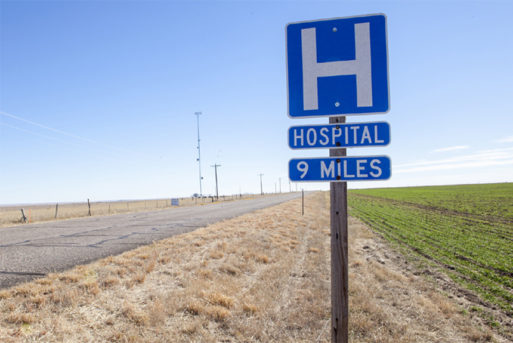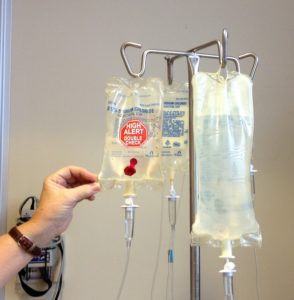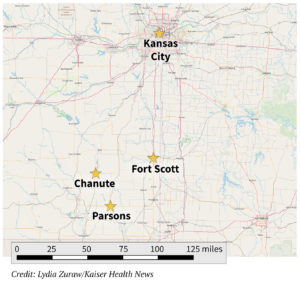
Credit: Colorado Managed Care
It’s common knowledge in the healthcare community that access to medical care in rural communities is a serious problem. Rural communities historically have more barriers to care than their urban counterparts, including long travel times, lack of money for gas, lack of insurance coverage and poor health literacy, to name only a few. What’s more, an increasing shortage of primary care physicians and a rash of rural hospital closures are taking the situation from bad to worse.
This is certainly the case for the small community of Fort Scott, Kansas, where the rural hospital that served its 7,800 residents closed its doors late last year. Owned by Mercy, a St. Louis-based nonprofit health system, the 69-bed facility simply wasn’t pulling its own weight. Most inpatient beds at Mercy Fort Scott were empty much of the time, and revenues were down. The closure was anticipated and inevitable, said Reta Baker, the hospital CEO.

Specialized cancer care isn’t available in
many rural communities
Still, Mercy took some steps to obviate the hardship the closure would cause by agreeing to “keep the lights on” and fund the continuation of a few specialty clinics through 2021. Initially, this included the hospital’s outpatient cancer unit, dubbed the Unit of Hope. But then Cancer Care of Kansas, the contractor that managed the unit, decided to shut it down — with two weeks notice — on Feb. 1, 2019.
According to Cancer Care’s CEO Yoosaf “Abe” Abraham, people who had the dual misfortune of living in Fort Scott and having cancer could simply travel to the company’s other locations in Chanute and Parsons for their care. Unfortunately, those facilities are 50 and 63 miles, respectively, from Fort Scott.
Worse Care, More Deaths
Cancer patients in rural communities already don’t do as well as they should. According to The Centers for Disease Control and Prevention, the incidence of preventable cancers such as those related to smoking has slowed in metropolitan areas but held steady in rural communities. Further, cancer mortality is higher in rural communities than in metropolitan areas, a disparity that is most likely related to diminished access to cancer screening and specialized medical care says the CDC.
Krista Potsai, who runs the four outpatient clinics at Fort Scott that remain open, concurs. It’s not uncommon, she says, for the staff to ““see someone walk in [with] end-stage cancer that they put off because they didn’t have money, they didn’t have insurance, or it’s just the way you are.”
Grueling Travel Times

A map shows the distance patients in Fort Scott travel for care
Credit: Lydia Zuraw/Kaiser Health News
Meanwhile, cancer patients stuck in rural America endure grueling travel across often-deserted terrain to get the care they need. Take Karen Endicott-Coyan, a 65-year-old Fort Scott resident who travels the 50 miles to Chanute for her chemotherapy each week. Because the treatment makes her sick, she tries to recruit a friend to accompany her to her appointment, but that’s not always an easy task. Sometimes she has to skip her pain medication so she can safely drive herself.
In fact, traveling to appointments — and the money it costs to do so — are an enormous burden for cancer patients living in rural communities. According to a report from the American Society of Clinical Oncologists, rural cancer patients spend an average of 66 percent more time traveling to appointments than those in metropolitan areas. What’s more, they often don’t have the money to fund the trips. Last year, Fort Scott’s cancer support group, Care to Share, gave away $17,000 in gas vouchers in that small community alone.
Are Alternatives Available?
Some alternative care models that could serve rural cancer patients in their communities are in use in other parts of the country, KHN reports. For example, Sanford Health in South Dakota and Thomas Jefferson University Hospitals in Pennsylvania deliver cancer therapy in patients’ homes. But cancer therapy is very specialized, and it takes time and money to get the infrastructure in place. So for now, patients like Ms. Endicott-Coyan will have no choice but to travel long distances to get the care they need.
Note: Kaiser Health News will be following the story of Fort Scott over the next year, and reporting on the outcome for the patient and the community in the ongoing series No Mercy.

 Cancer Patients in Rural Community Suffer When Hospital Shuts Its Doors
Cancer Patients in Rural Community Suffer When Hospital Shuts Its Doors



 “Help Me, Helen”
“Help Me, Helen”















